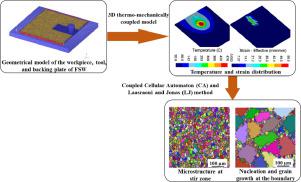当前位置:
X-MOL 学术
›
Int. J. Mech. Sci.
›
论文详情
Our official English website, www.x-mol.net, welcomes your feedback! (Note: you will need to create a separate account there.)
Numerical modelling of microstructure in friction stir welding of aluminium alloys
International Journal of Mechanical Sciences ( IF 7.3 ) Pub Date : 2020-11-01 , DOI: 10.1016/j.ijmecsci.2020.105882 Md Perwej Iqbal , Ashish Tripathi , Rahul Jain , Raju P Mahto , S.K. Pal , P. Mandal
International Journal of Mechanical Sciences ( IF 7.3 ) Pub Date : 2020-11-01 , DOI: 10.1016/j.ijmecsci.2020.105882 Md Perwej Iqbal , Ashish Tripathi , Rahul Jain , Raju P Mahto , S.K. Pal , P. Mandal

|
Abstract Mechanical properties like strength and hardness depend largely on microstructure. The conventional methods to evaluate microstructure such as optical and electron-based microscopy require a substantial amount of time and are expensive as well. To deal with this issue, the present work reports evaluation of the microstructure via numerical modelling in friction stir welding (FSW). This includes a 3-D thermo-mechanical model built on the Lagrangian implicit formulation. It has been experimentally validated for different processing conditions. A coupled approach combining Cellular Automaton (CA) and Laasraoui and Jonas (LJ) with the thermo-mechanical model is followed. Temperature, strain and strain rate form the inputs from the developed model to predict the microstructure. Nucleation and grain growth have also been considered in the model. The results have been validated by comparing the experimentally obtained grain size results at the weld zones namely stir zone, thermo-mechanically affected zone and heat-affected zone; and the percentage errors are 7.3%, 10.6%, and 8.5%, respectively. The effects of two key process parameters (tool rotation (ω) and welding speed (v)) on temperature and effective strain have been investigated and correlated with the obtained grain size.
中文翻译:

铝合金搅拌摩擦焊微观结构的数值模拟
摘要 强度和硬度等机械性能在很大程度上取决于微观结构。评估微观结构的传统方法,如光学和电子显微镜,需要大量的时间,而且也很昂贵。为了解决这个问题,目前的工作报告了通过搅拌摩擦焊 (FSW) 中的数值建模来评估微观结构。这包括建立在拉格朗日隐式公式上的 3-D 热机械模型。它已针对不同的加工条件进行了实验验证。遵循将元胞自动机 (CA) 和 Laasraoui and Jonas (LJ) 与热机械模型相结合的耦合方法。温度、应变和应变率形成来自开发模型的输入,以预测微观结构。模型中还考虑了成核和晶粒生长。通过比较焊接区(即搅拌区、热机械影响区和热影响区)的实验获得的晶粒尺寸结果,结果得到了验证;百分比误差分别为 7.3%、10.6% 和 8.5%。研究了两个关键工艺参数(工具旋转 (ω) 和焊接速度 (v))对温度和有效应变的影响,并将其与获得的晶粒尺寸相关联。
更新日期:2020-11-01
中文翻译:

铝合金搅拌摩擦焊微观结构的数值模拟
摘要 强度和硬度等机械性能在很大程度上取决于微观结构。评估微观结构的传统方法,如光学和电子显微镜,需要大量的时间,而且也很昂贵。为了解决这个问题,目前的工作报告了通过搅拌摩擦焊 (FSW) 中的数值建模来评估微观结构。这包括建立在拉格朗日隐式公式上的 3-D 热机械模型。它已针对不同的加工条件进行了实验验证。遵循将元胞自动机 (CA) 和 Laasraoui and Jonas (LJ) 与热机械模型相结合的耦合方法。温度、应变和应变率形成来自开发模型的输入,以预测微观结构。模型中还考虑了成核和晶粒生长。通过比较焊接区(即搅拌区、热机械影响区和热影响区)的实验获得的晶粒尺寸结果,结果得到了验证;百分比误差分别为 7.3%、10.6% 和 8.5%。研究了两个关键工艺参数(工具旋转 (ω) 和焊接速度 (v))对温度和有效应变的影响,并将其与获得的晶粒尺寸相关联。



























 京公网安备 11010802027423号
京公网安备 11010802027423号